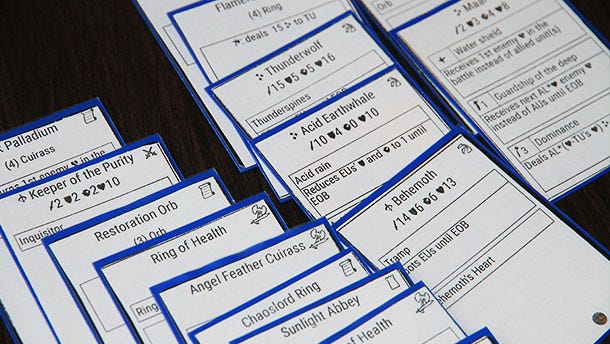Trending
Opinion: How will Project 2025 impact game developers?
The Heritage Foundation's manifesto for the possible next administration could do great harm to many, including large portions of the game development community.
How we tested early prototypes of our digital card game and what we have learned.

We are small indie studio from Ukraine focused on Soulsmith card game creation. In this article we would like to share our experience of testing early paper prototypes and what we have learned from it.
The reason why you need a paper prototype is quite obvious and well-known by every game designer - creating a test build requires a lot of time and efforts. Testing small balance changes is not a big deal even if you have to prepare a new build. At early development stages, on the other hand, you can't afford spending a significant amount of resources every time you need to test something fundamental, especially if you are an indie developer.
As Jesse Shell stated in his wonderful "The Art of Game Design" book, it's quite possible to make a paper prototype even for a first person shooter. Fortunately, if you are making digital card game you won't need one person for each character. You'll need quite a few things:
1. An IT geek and a gamer (that's me);
2. A bunch of MTG cards from good old days;

3. Deck protector sleeves and pieces of paper with some weird symbols and numbers;

4. Another addicted card game fan (that's Anna);
_305.jpg/?width=305&auto=webp&quality=80&disable=upscale)
5. Old magnetic "Almost Every Desktop Game In 1" (or something similar) set;

6. Some dices and coins;

7. Woolen handmade whale (optional).
_610.jpg/?width=610&auto=webp&quality=80&disable=upscale)
That's it, you are all set and ready to go! BTW, things may escalate quickly. These red dices on my cards are damage counters and I'm not happy about it.
_on-my-cards_305.jpg/?width=305&auto=webp&quality=80&disable=upscale)
Still, hope never dies. Especially if it is supported by battlemages on one lane and a firewitch covered by an armored knight on the other!

You see, you can easily test core mechanics with paper prototype of your digital card game. Just don't forget to make additional notes when you test the main idea or solution as you may forget them later, trust me.
When your prototype is mature enough, it's possible to literally play the game you make. We learned that it's very useful to play your prototype a lot even if it's (almost) final. Playing your game by yourselves, inviting friends to a pizza party and playing together, trying to find new sneaky strategies and super strong combos - everything helps in finding hidden issues in your gameplay. Difficulties with ending the game when one player is far ahead, lack of comeback mechanics in certain situations, dumb dominant strategies, stalemate scenarios, and many other nasty things can be found only after dozens or even hundreds of playing sessions if your game is deep enough. It's better to find and solve core gameplay problems in a paper prototype and not when everything is coded.
Last but not least. After months of playing final prototype, when you become an expert in your own game and if you still love it, you can hope that players will also love the game. That is why you make it, at the end.
P.S. Including a couple of links for those interested in who we are and what we do:
https://www.facebook.com/PlaySoulsmith
https://playsoulsmith.com
Read more about:
BlogsYou May Also Like